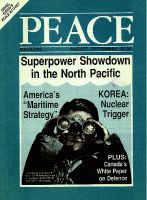
Peace Magazine Aug-Sep 1987, page 6. Some rights reserved.
Search for other articles by Phil Esmonde here
By Phil Esmonde
Recent headlines claiming Soviet submarines have penetrated the Strait of Juan de Fuca underline the vital need for arms control on the oceans and specific disengagement policies in the Pacific, where the Soviet Union and the United States meet daily. This type of constant intelligence activity is carried out by both the USSR and the U.S. Its frequency is increased by provocative naval policies and deployments of new weapons such as American Trident submarines. Two American submarines frequently change their "acoustic fingerprints," disguise themselves as Soviet submarines and ply the seas of Japan and Okhotsk. An American submarine and a Soviet submarine collided in this area a few years ago. It is partially this "cat and mouse" game which keeps each side "trigger ready" and each of us dangling on the nuclear edge.
Both superpowers are engaged in a navy buildup in the Pacific. There is also a fast and furious selling by the U.S. of a "Soviet threat" in the Pacific. Over the last year our newspapers and magazines have been generously sprinkled with stories on "Soviet adventurism in the Pacific," "aggressive Soviet expansion," etc. Pressure has been applied to allies such as Canada and Japan to increase their forces. Canada responded by announcing that two ships will be shifted from our East to our West Coast, and we are now going to buy nuclear submarines for Arctic use. It is in this light that the recent headlines about Soviet subs in the Strait of Juan de Fuca need to be viewed. The news article stated that navy officials know of "routine Soviet submarine penetrations in the area since the late 1970s." If these are "routine penetrations," why are we getting banner headlines now? In the words of William Arkin of the Institute for Policy Studies in Washington, D.C., "There is a Soviet threat being manufactured in the Pacific." The U.S. claims the Soviet Pacific buildup is manifested by the Soviet naval base at Cam Ranh Bay in Vietnam. In what Jane's Defence Weekly (February 21, 1987) described as "an unusual release of surveillance material," the United States held a press conference, presented photos of Cam Ranh Bay and claimed it was the biggest Soviet base outside the USSR. Given this claim, it will be revealing to see the U.S. response to Vietnam's recent offer to close Soviet access to Cam Ranh Bay in exchange for the U.S. pulling out of its bases in the Philippines and Australia. This Soviet offer (via proxy) will likely meet with an aggressive "no" or a lengthy silence.
A similar response was given to another major Soviet offer during Gorbachev's "Pacific speech" in Vladivostok last July.
Gorbachev called for bilateral discussions aimed at diminishing naval activities in the region, in particular the operations of nuclear-armed and nuclear-powered ships and a regional dialogue on security problems. Neither was picked up by the United States. If anything, the manufacture of the "Soviet threat" has increased since that time. The reason? Any reduction of naval activities in the region would work against U.S. naval "forward offensive strategy."
Provocative in nature, the American forward offensive strategy is part of the reason for the Soviet naval buildup. Substituting for its lack of conventional military power and its political and economic weakness in the Pacific, the Soviet Union has built a giant nuclear arsenal poised over the region like a sledgehammer. The Soviets make clear that any attack on their forces or homeland will bring down the nuclear sledgehammer's full weight. It is in this regard that U.S. naval policy is chilling. The forward offensive strategy, in the words of U.S. Navy Secretary John Lehman, is the achievement of "outright maritime superiority over any powers which might attempt to prevent our use of the seas and the maintenance of our vital interests worldwide;" a shift from sea lane defence policy to one "visibly offensive in orientation, (with) offensive power... widely distributed throughout the fleet." According to Lehman, "We must be able to threaten the potential adversary in his most secure areas." U.S. policy means keeping increasing pressure on Soviet forces in their home waters. Canada and other U.S. allies are being drawn more deeply into this strategy through joint military exercises, development of anti-submarine warfare techniques and assisting dispersal of the U.S. fleet by constant and growing ship visits to their ports.
It is vital that Pacific arms control talks be started. It is vital that we develop disengagement policies. It is also vital that we recognize that the Soviet Union is a Pacific country. Bill Hayden, Australia's Foreign Affairs Minister, stated in Australian News Bulletin (March 18, 1987) that the Soviet Union is a major littoral power in the Pacific. He went on to say, "It's better to draw them out than to try and isolate them and encircle them and threaten them with punishment. You do that to an individual, you get paranoid characteristics developing. You do that to a race of people or a country of people, the same sort of thing will happen." The sudden increase in "Soviet threat" stories seem destined to justify U.S. forward offensive strategy, to get allies more deeply involved and to increase arms deployments on the oceans. This is definitely not what is needed. We must address the increasing naval arms race not with more weapons, but with arms agreements.
Phil Esmonde is a member of the Greater Victoria Disarmament Group and sits on the coordinating council for the Pacific Campaign to Disarm the Seas, a non-aligned campaign to draw attention to the increasing militarization of the Pacific Ocean and the need for constructive arms control and disengagement policies in the region.

Peace Magazine Aug-Sep 1987, page 6. Some rights reserved.
Search for other articles by Phil Esmonde here